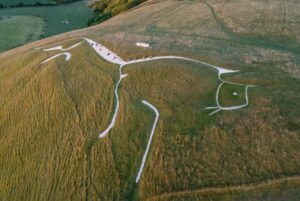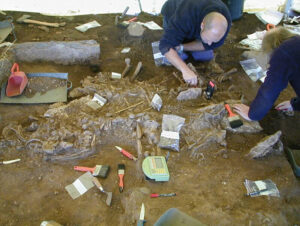We explore some of the most valuable treasure hoards ever found, from golden crowns in Poland to an eye-popping 68,000 silver coins on the isle of Jersey.
Sroda treasure
Found in the 1980s in the town of Środa Ślaska, Poland, the Środa Treasure is a 14th-century hoard of gold and silver coins, precious stones, jewelry, and a gold crown. It is worth a cool $120 million.

Środa treasure crown. Photo: Tlumaczek
Workers discovered the hoard during demolition work in 1985. Throughout several excavations until 1988, construction workers uncovered almost 4,000 silver and florin gold coins, three rings, two gold pendants, a clasp, and a magnificent crown. Some items sustained damage during excavation.
The treasure likely belonged to Charles IV, the Holy Roman Emperor between 1355 and 1378, and his wife Blanche of Valois.
Staffordshire Hoard
Perhaps the most famous treasure discovery in Britain, the Staffordshire Hoard is over $4 million worth of well-preserved Anglo-Saxon riches, including four kilos of gold.
The hoard dates to the 7th century AD, a time of political, social, and cultural shifts in England. The Kingdom of Mercia grew in power and notoriety, establishing its dominance over the kingdoms of Wessex, East Anglia, and Northumbria. Christianity also gained popularity during this period.

Items from the Staffordshire Hoard. Photo: David Rowan/Birmingham Museum and Art Gallery
Authorities uncovered the hoard in 2009 in Lichfield, Staffordshire after Terry Herbert, a hobbyist in a metal detection club, came across gold artifacts in landowner Fred Johnson’s field. The pair contacted the authorities. English Heritage, in collaboration with Birmingham Archaeology, launched a full-scale excavation of the field with Johnson’s permission. The archaeologists discovered a couple of hundred gold objects.
Follow-up excavations in 2012 and 2013 found more treasure. Today, the hoard totals 4,600 gold, silver, and garnet items. Apart from the 4kg of gold, the silver weighs another 1.7kg. There are also 3,500 garnet artifacts.
The treasure has a strong militaristic character. It contains Christian objects like crosses, gold strips with inscriptions, gold sheets, a silver helmet, sword hilt fittings, sword pommel caps, and scabbard pendants. There were no coins or women’s jewelry in the hoard. Historians don’t know who buried it and for what purpose.
Under the Treasure Act of 1996, the Treasure Valuation Committee paid out the equivalent of $4 million to Terry Herbert and Fred Johnson. Since the money had to be split between the two men, it caused a very public falling out. They accused each other of greed and parted ways on bad terms.
Hoxne hoard
The Hoxne Hoard dates to the 4th and 5th centuries AD when Rome was losing control of Britain. This period saw the Anglo-Saxon “barbarians” beginning to invade, general economic decline, withdrawal of the Roman army, and general misrule. This has led historians to believe that the treasure was buried to protect the owner’s wealth. It could have been the property of a wealthy Roman family living in Britain at this unstable time.
In 1992, another metal detectorist, Eric Lawes, found the hoard on a farm in Hoxne, Suffolk, while looking for a hammer. He uncovered a bunch of spoons and coins and decided to contact the police and the Suffolk County Council.

Hoxne Hoard on display at the British Museum. Photo: Mike Peel
Lawes and farmer Peter Whatling split the £1.75 million payout, the equivalent of $4.6 million today.
The treasure consists of around 15,000 coins (gold, silver, and bronze) as well as jewelry, pepper pots, silver spoons, ladles, a vase, bowls, a beaker, and a unique body chain. The coins were struck during the reigns of 4th-century leaders such as Constantine II, Valentinian I, and Honorius.
Details on a bracelet and spoons give archaeologists some indication of who might have owned these riches. The bracelet bears a Latin inscription saying, “Use this happily, Lady Juliane.” Other spoons bear the name Aurelius Ursicinius.
Cuerdale hoard
On an unassuming day in May 1840, workmen tending to repairs by the River Ribble in Cuerdale, Lancashire, came across a peculiar lead chest. Incredibly, they had stumbled on one of the largest Viking treasures of all time.
The hoard contained only silver items, totaling an incredible 8,600 pieces. This includes Scandinavian, Anglo-Saxon, Frankish, Kufic, Islamic, Byzantine, Carolingian, Papal, and Danelaw coinage, and bullion in the form of rings and brooches. After an inquest in 1840, the hoard passed to the Duchy of Lancaster under Queen Victoria.

Cuerdale hoard in the British Museum. Photo: JMiall
Viking treasure burials are not all that unusual. Historians speculate that Vikings buried their wealth in unstable times to keep them safe. The owners may have had to flee in a hurry. Or they may have buried the treasure for the owners to take to Valhalla when they died.
La Câtillon II hoard
This discovery was 30 years in the making. In the 1980s, on the British island of Jersey, a woman told two metal detectorists named Richard Miles and Reg Mead that her father’s farm contained ancient coins. The pair were allowed to search the farmer’s field for a day but found nothing.
Three decades later, in 2012, they finally found a massive hoard of 68,000 coins and jewelry. The coins, glass beads, and gold neck torcs date from 50 BC.

Coins from the La Câtillon hoard fused in soil. Photo: Neil Mahrer/archaeology.co.uk
Completely fused, this hoard was a 140cm by 70cm by 15cm hunk of corroded, green Celtic coins, found one meter below the surface. Jersey Heritage and other official bodies consider it the world’s largest Celtic coin hoard. The Jersey government paid $5.2 million for the hoard.
Preserving it was a painstaking process. First, they had to take the large block out of the ground with a crane. It weighed over a ton. It then took over three years to separate and clean each coin.
As for who buried it, it might have been a Celtic tribe fleeing from the Romans.
Panagyurishte treasure
In 1949, three Bulgarian brothers accidentally found golden treasure belonging to the Thracian civilization. They were digging for clay in Pansgyurishte, Bulgaria when they found nine 24-karat golden vessels. These included a phiale, drinking horn, amphora-rhyton, decanter, and a whistle most likely used as tableware and for religious rituals. They found the treasure two meters below the surface.

Panagyurishte treasure in Sofia, Bulgaria. Photo: Ann Wuyts
The 6.1kg of gold dates to the 3rd and 4th centuries BC. The treasure likely belonged to the Thracian king, Seuthes III. The vessels depict Greek mythology and history and show Hercules, Alexander the Great’s conquests, and other aspects of the Thracian culture.
This treasure trove has no estimated value. Historians deem it priceless.






